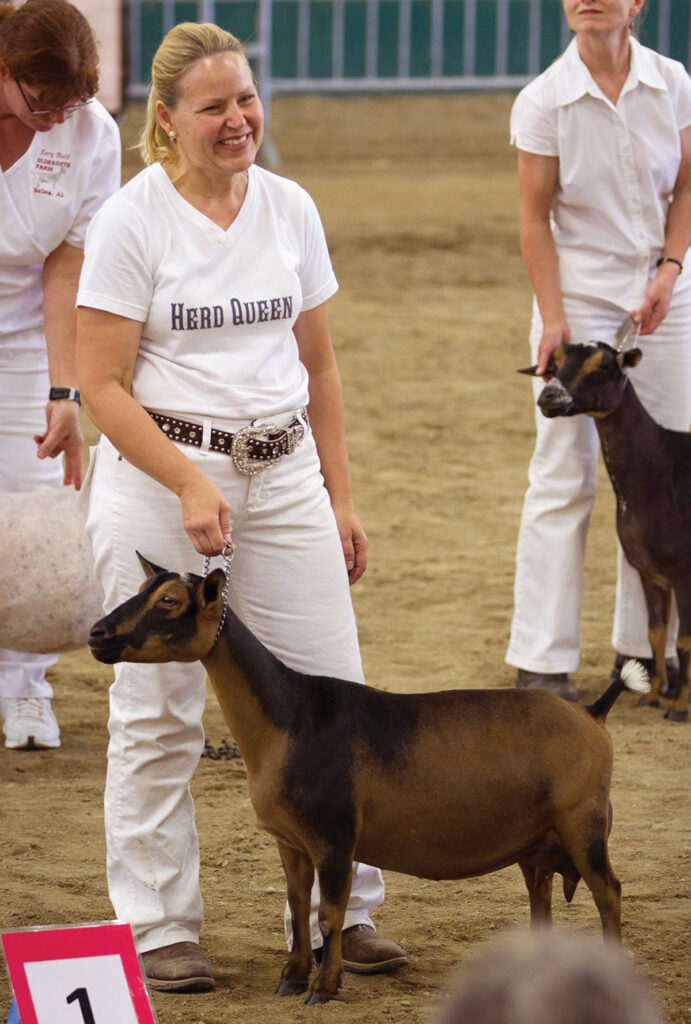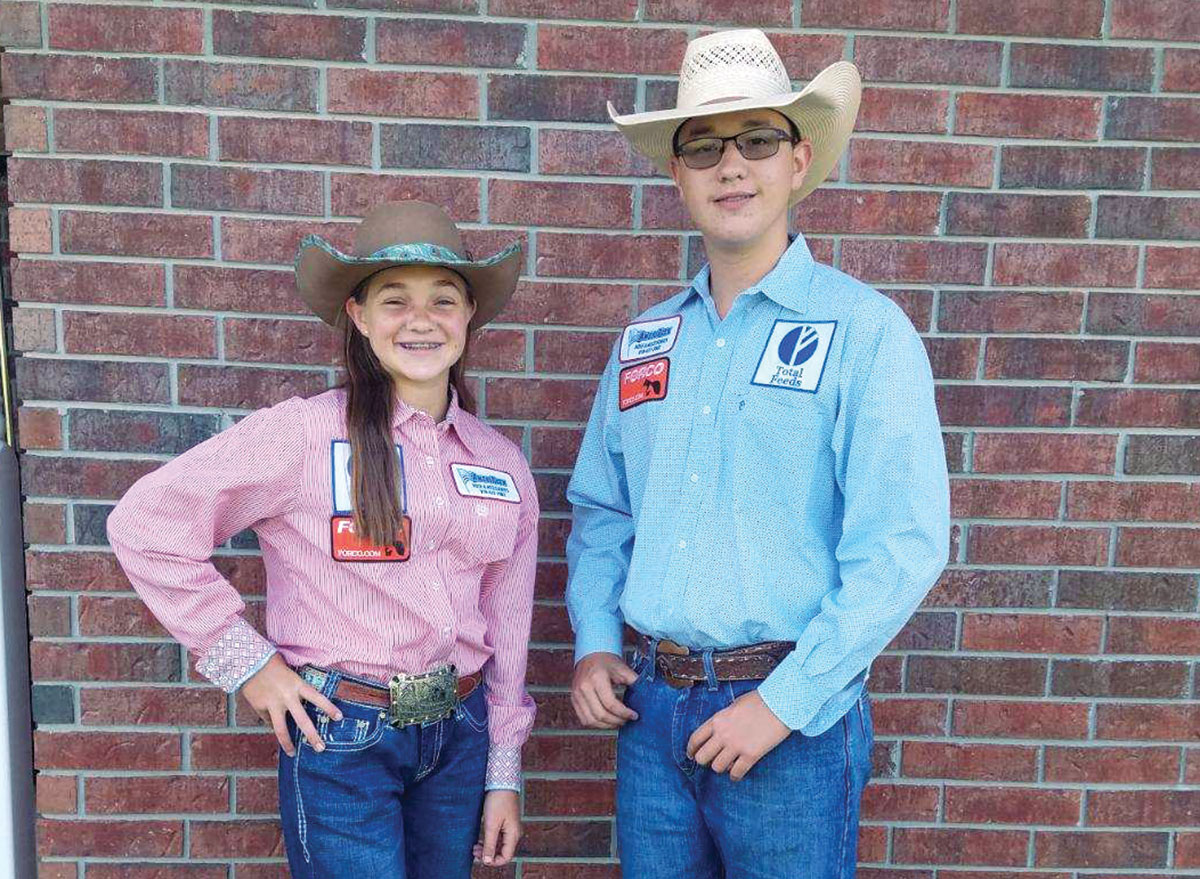
Ellen Dorsey’s “hobby” became a full-time occupation
Ellen Dorsey started her goat career with Pygmy goats over two decades ago.
By 2005, Ellen’s “hobby” became a full-time business known as Dill’s-A Little Goat Farm, Dorsey-Lane Dairy Goats, and Dorsey-Lane Cattle Company in Chelsea, Okla,. The farm specializes in Nigerian Dwarfs, Alpines, Toggenburgs and black Angus stock cattle on their 24-acre farm located northeast of Claremore, Okla.
The number of adult dairy goats fluctuates between 75 and 100 and the farm also runs 40 head of cattle. Many of the herd are award-winning goats with the American Dairy Goat Association, including Premier Exhibitor and Premier Breeder of the Nigerian Dwarf breed for many years at the Tulsa and Oklahoma state fair, and the ADGA National Show.
Chris is the farm’s “operations manager” while Ellen does the milking, baby feeding, and general doctoring.
“I like to tell him ‘he builds the operation, I build the goat,’” Ellen said.
The family has six sons, Jason, Joshua, Jonathon, Justin, Jarred and Jacob. The four oldest sons have families of their own, while the younger sons, Jarred and Jacob, help on the ranch.
Jarred and Jacob lead the grandkids as chief suppliers of hugs for the littlest goats.
Dill’s-A Little Goat Farm, Dorsey-Lane Dairy Goats, and Dorsey-Lane Cattle Company provides dairy and milk, beef, and kid sales, as well as linear appraisal and production testing.
The primary business is supplying kids to the breeding market.
“Milk is a bonus part of what I do,” Ellen said. “Our goal is to produce a quality product for the market. We provide fresh sweet rich milk, and our beef is well-raised meat.”
The move to goats reads live a romance novel.
“I fell in love with goats as a species and then I discovered (Dwarf) Nigerians,” Ellen said. “From there I progressed to the standard breeds and have a love for each one.
“I like each one for a variety of reasons, but the Nigerian Dwarf has my heart and always will.
“They make my heart happy.”
The Nigerian Dwarf has the highest butterfat and protein among the miniature goat breeds.
“I also find their milk sweeter than the other breeds which is the primary reason I bottle it for my ‘human’ customers,” Ellen said.
Ellen describes the Nigerian Dwarf goats as “hardy animals” and easy to live with and care for, if you know what you’re doing.
When the farm needs lots of milk fast, the Alpines and Toggenburgs are the “go to” animal for that task, she said.
Oklahoma law allows the sale of 100 gallons of milk per month with no licensing required. The average production for of an adult does is 5 pounds per day for the Nigerian, 10 to 12 pounds per day for the Alpines and 11 to 14 pounds for the Toggenburgs.
The Dorsey’s participated in a USDA study and found their program is collaborating nicely with little worm load in any of their pastures.
“The highest was among the junior stock as expected since they aren’t in the milk rotation they don’t get near as much attention as the adult stock,” Ellen said.
“The goats haven’t been vaccinated in recent years since we found nothing changed over the years,” Ellen said. “We do however vaccinate our cattle for a variety of things using commercially available products. We also take all of our heifers to the vet for brucellosis testing.”
Ellen’s goats are show goats, so hoof trimming done on a regular basis is part of the farming routine, she said.
“A dairy goat with good hoof maintenance milks better,” Ellen said. “She gets around and can feed herself pain free. It translates to more milk in the bucket.”
While the Dorseys do not make soap, they have many customers who buy milk for soap making purposes, she said.
The buck kids are typically sold as bottle babies to individuals looking for pets or to raise for meat.
“I breed the way I know to breed and have enjoyed a lot of success as a line breeder,” Ellen said.
“We’re very hands on, so we keep track of animal health all the time,” Ellen said.
The feed program is based on a well-balanced calcium phosphorus ratio using dairy cattle feeds, alfalfa pellets, alfalfa hay during peak milking season, free choice prairie hay year-round, pasture year-round and always fresh water available.
Ellen also uses a good loose mineral made especially for dairy goats. The cows are also on a commercial cattle feed, free choice hay, pasture, and fresh water.
“If we see an issue, we’re quick to treat that issue, or haul the animal to the vet for a professional opinion and treatment,” Ellen said.

Ellen likes most of the herd to kid in the spring, then milk until October when they dry off most of the herd, so Ellen can attend the Annual Meeting and Convention for the American Dairy Goat Association where she is District 10 director.
“When I leave for the week, my husband takes vacation from his full-time job to take care of my goats and milk for me,” Ellen said. “He only milks once a day, so I try to make it easy on him and leave only my heaviest milkers on the line, so we continue to have milk for customers and our household.”
“The secret to live birth kids is being there,” Ellen said. “Lots of full-term kids are lost because no one is there to ensure they get the care they need, how much more those that are a little weak.
“When you are there, the kids get cleaned off, their lungs are clear, and they get their colostrum. We bottle raise everything here and we use baby monitoring system.
Ellen has been known to set up a cot and just stay with her “girls.”
“We have a one-room apartment attached to our shop that has a walk-in closet and a bath,” Ellen said. “There is shelving in the bathroom that makes a nice spot for bottles, a pasteurizer and extra medications. We have room for a couple of freezers and miscellaneous kidding supplies.”
There are also seven playpens set up to receive the kids once they’re dried off, she said.
“They stay in here for a couple of days before being sent out to kid pens,” Ellen said.
The Dorseys favor the springtime, typically from February through May, for their baby boom of kids.
Winter and early spring kids tend to be healthier since they aren’t challenged by as many microorganisms living in the ground.
“That’s really the opportune time to put kids on the ground,” Ellen said. “The shows are in the spring; you have to have goats in milk to show.”
“Embryo transplanting is becoming big business in dairy goats, but I haven’t taken the opportunity to explore that end due to the expense involved,” Ellen said.
Ellen also breeds a handful of does in the fall for winter kids.
“It’s nice to have newly fresh does for winter. Those kids pay the feed bill and give my children a nice Christmas,” Ellen said.







